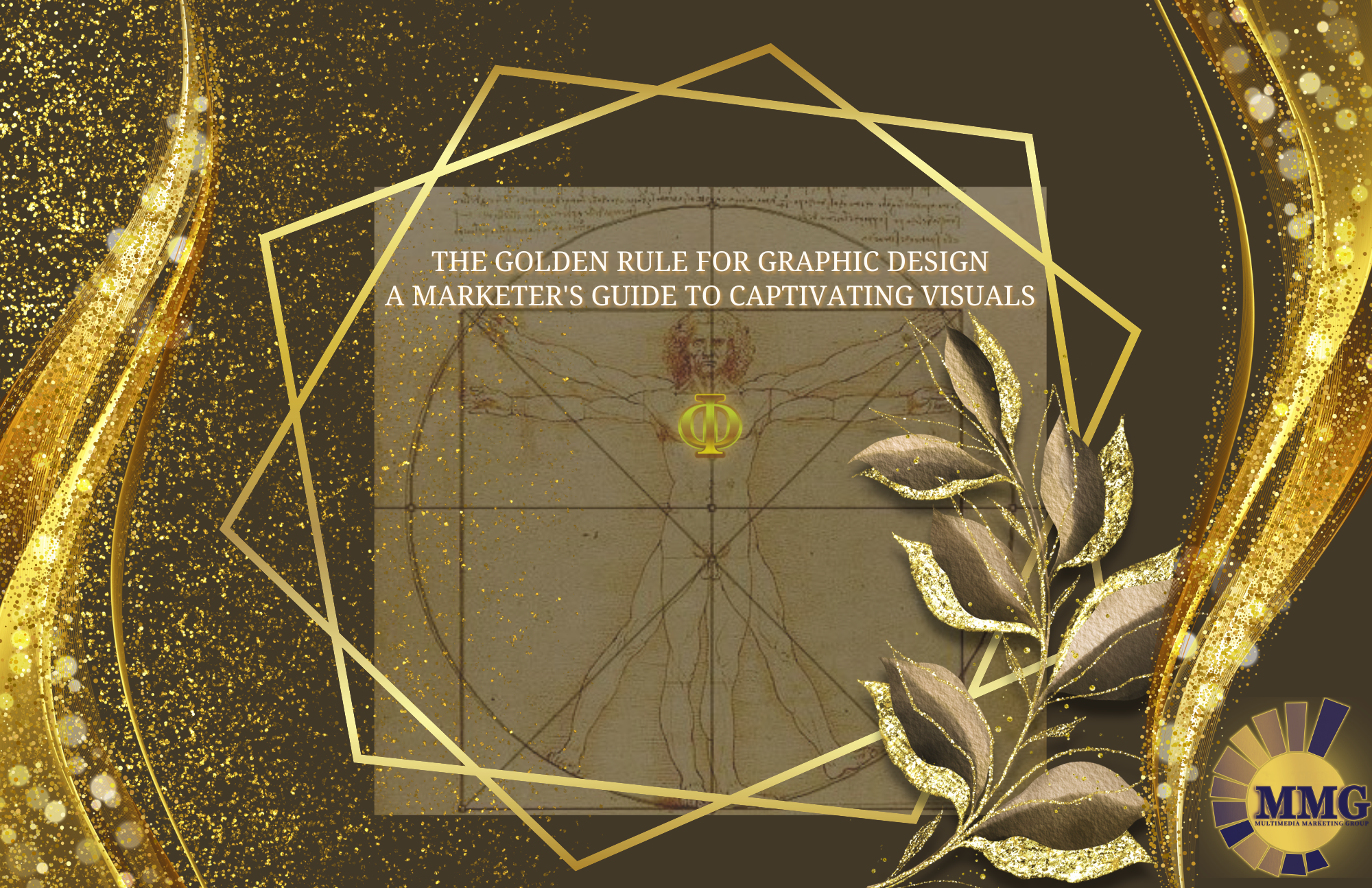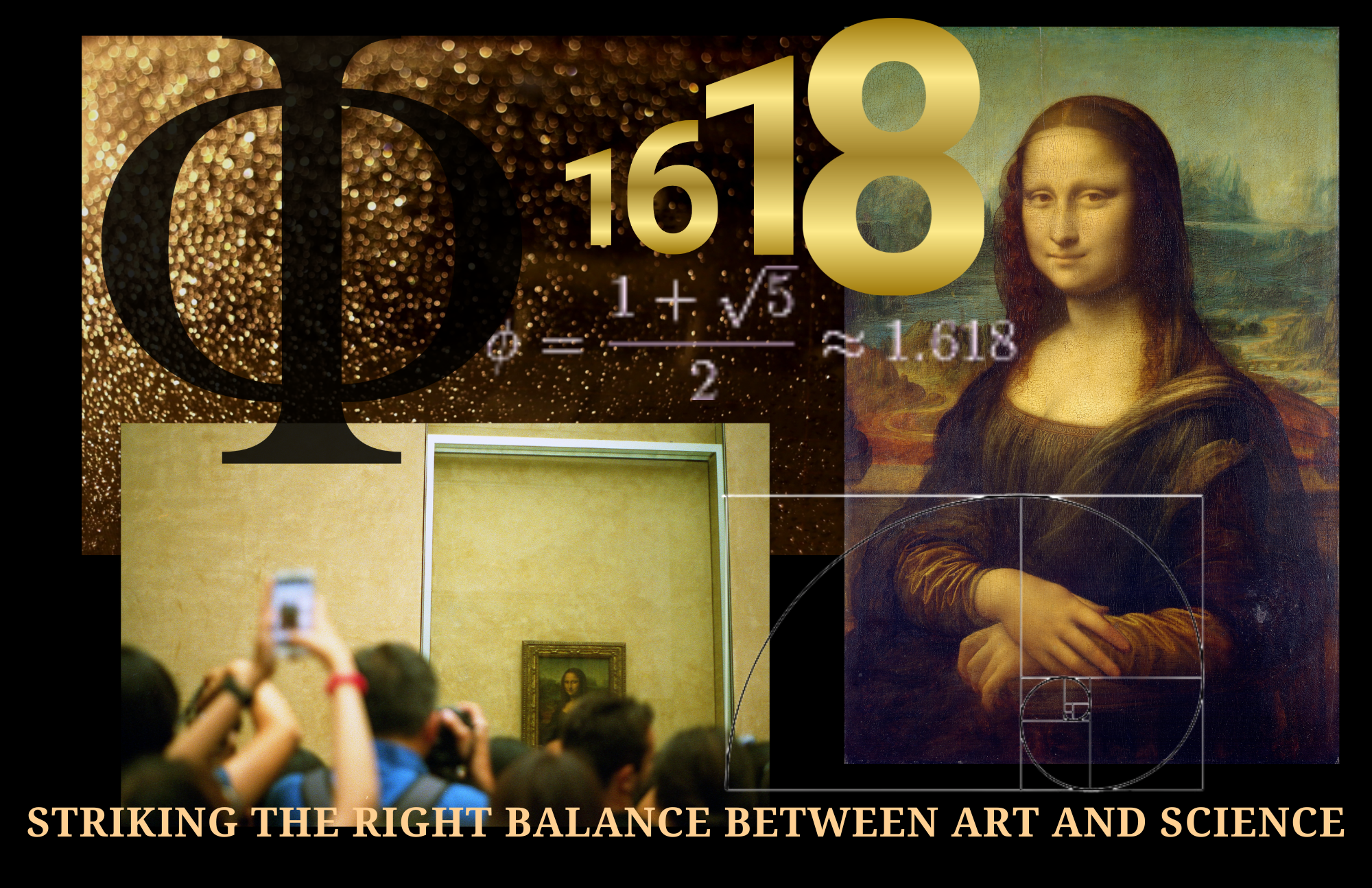
The Golden Rule for Graphic Design
A Marketer's Guide to Captivating Visuals
In the dynamic world of marketing, effective communication is paramount. When it comes to engaging with audiences, graphic design plays a pivotal role in conveying messages, capturing attention, and establishing brand identity. Among the various design principles, one rule stands out – the Golden Rule of Graphic Design. In this blog, we will delve into the essence of the Golden Rule and explore its application for marketeers to create visually stunning and captivating designs. Delve into aspects like the use of the Golden Ratio in photography and image composition, practical examples of famous designs that apply the Golden Ratio, case studies of successful marketing campaigns utilizing this principle, and the benefits of adopting the Golden Rule for graphic design in marketing.
Understanding the Golden Ratio and Its Significance
The Golden Ratio, often denoted by the Greek letter Phi (Φ), is a special mathematical ratio of approximately 1.618. It is found in many natural phenomena, art, and architecture, and has been used for centuries to create visually appealing compositions. The Golden Ratio appears in the Fibonacci sequence, a sequence of numbers where each number is the sum of the two preceding ones (e.g., 0, 1, 1, 2, 3, 5, 8, 13, and so on). The ratio of consecutive Fibonacci numbers approaches the Golden Ratio as the sequence advances.
The significance of the Golden Ratio lies in its ability to create a sense of harmony, balance, and proportion, which is visually pleasing to the human eye. By applying this principle to graphic design, marketeers can evoke positive emotional responses from their audiences, leading to increased engagement and retention.
Composition and Layout
One of the fundamental applications of the Golden Ratio in graphic design is for creating well-balanced compositions and layouts. Designers can use the ratio to determine the placement and proportions of elements on a canvas or a webpage. Dividing the canvas into sections according to the Golden Ratio can guide the positioning of focal points and key content areas, leading the viewer’s eye smoothly through the design.
Typography
Typography is a vital aspect of graphic design that significantly impacts the readability and aesthetics of marketing materials. The Golden Ratio can be employed to establish harmonious proportions between font sizes, line heights, and margins, ensuring a visually appealing and easy-to-read text. This creates a sense of coherence and professionalism in the design, boosting the overall impact of the marketing message.
Logo Design
A brand’s logo is its visual identity and a crucial element in marketing campaigns. Applying the Golden Ratio in logo design can lead to a balanced and visually striking emblem that resonates with the target audience. From determining the proportions of individual logo elements to the placement of text and graphics, the Golden Ratio helps achieve a sense of symmetry and elegance that leaves a lasting impression.
Color Theory and the Golden Rule
Incorporating the Golden Ratio into color selection and combinations can further enhance the impact of graphic designs. Harmonious color schemes can be achieved by using the Golden Ratio to determine the ratio of colors within the design. By carefully selecting colors that complement each other in a proportionate manner, marketeers can evoke specific emotions and associations that align with the brand’s message.
Web Design and the Golden Ratio
In the digital age, web design is a critical aspect of marketing strategies. Incorporating the Golden Ratio into web layouts can create a user-friendly and visually pleasing online experience. Marketeers can use the Golden Ratio to determine the proportions of key website elements, such as the header, navigation menu, content area, and sidebar. By adhering to these proportions, the website achieves a balanced and cohesive appearance, keeping visitors engaged and encouraging them to explore further.
Photography and Image Composition
The Golden Ratio can also be applied to photography and image composition. When framing photographs or designing visuals for marketing materials, consider placing key elements along the lines or intersections defined by the Golden Ratio. This technique draws the viewer’s attention to the main subject and creates a natural flow within the image. Additionally, the Golden Ratio can guide the placement of negative space, enhancing the overall aesthetic appeal.
Real-World Examples of the Golden Ratio in Graphic Design
Numerous famous artworks and designs throughout history have utilized the Golden Ratio, often subconsciously, to create captivating and visually harmonious compositions. For instance, Leonardo da Vinci’s “Mona Lisa” and “The Last Supper” are believed to incorporate the Golden Ratio in their proportions, as do masterpieces by renowned artists such as Michelangelo and Salvador Dali.
In the modern era, major companies have also embraced the Golden Ratio in their branding and marketing efforts. For instance, Apple’s logo is often cited as an example of the Golden Ratio in logo design, with its perfect balance of curves and proportions.
VII. Case Studies of Successful Marketing Campaigns
Market research has shown that designs based on the Golden Ratio tend to resonate more with audiences, leading to increased engagement and brand loyalty. Several marketing campaigns have successfully leveraged the Golden Ratio to leave a lasting impact on consumers. By analyzing these case studies, marketeers can gain valuable insights into how the Golden Rule can be applied strategically to achieve specific marketing goals.
VIII. The Benefits of Embracing the Golden Rule in Graphic Design
In conclusion, the Golden Ratio offers marketeers a powerful tool to create captivating and visually compelling designs. By incorporating this principle into their graphic design strategies, marketeers can achieve the following benefits:
- Increased Visual Appeal: Designs based on the Golden Ratio are naturally pleasing to the eye, capturing attention and leaving a positive impression on viewers.
- Enhanced User Experience: Applying the Golden Ratio in web design and typography improves readability and user-friendliness, leading to a more satisfying user experience.
- Strong Brand Identity: Logos and branding elements created with the Golden Ratio exhibit a sense of balance and professionalism, strengthening the brand’s identity and recognition.
- Emotional Connection: Harmonious color schemes and compositions evoke specific emotions and associations, enabling marketeers to establish a deeper emotional connection with their target audience.
By understanding and embracing the Golden Rule of Graphic Design, marketeers can elevate their marketing materials, stand out in a competitive landscape, and create a lasting impact on their audience.

IX. Practical Tips for Implementing the Golden Rule in Graphic Design
- Grid Systems: Utilize grid systems based on the Golden Ratio to create consistent and balanced layouts. Grids help maintain harmony across various design elements, ensuring a visually appealing end product.
- Golden Rectangle: The Golden Rectangle, a rectangle with sides in the Golden Ratio proportion, can serve as a guiding template for designing banners, posters, and social media graphics. Aligning elements to the corners or sides of the Golden Rectangle can create a harmonious visual flow.
- Iterative Design: Embrace iterative design processes to refine your designs and align them with the Golden Ratio. Repeatedly review and adjust your compositions until achieving the desired balance and proportion.
- Mobile Responsiveness: When designing for digital platforms, ensure your layouts remain visually pleasing and functional on various screen sizes. Incorporate the Golden Ratio in responsive design to maintain harmony across devices.
X. The Golden Ratio in Marketing Materials
- Brochures and Flyers: Design marketing collateral like brochures and flyers using the Golden Ratio to organize content, images, and graphics in a way that guides the reader’s eye through the material seamlessly.
- Social Media Posts: Incorporate the Golden Ratio in the design of social media graphics to create eye-catching posts that stand out in crowded newsfeeds.
- Website Banners and Hero Sections: Apply the Golden Ratio to website banners and hero sections to create visually captivating introductions that pique the visitors’ interest.
Advertisements: Whether for print or digital ads, the Golden Ratio can help marketers establish a focal point and hierarchy of information, ensuring that the core message stands out.
XI. Golden Ratio Tools and Resources
- Golden Ratio Calipers: Physical or digital Golden Ratio calipers can help designers measure and apply the Golden Ratio accurately in their artwork.
- Golden Ratio Grid Overlays: Use grid overlays or templates based on the Golden Ratio to guide your design process and ensure proportional balance.
- Golden Ratio Typography Calculators: Online tools can help calculate font sizes and line heights based on the Golden Ratio to create visually pleasing and legible text.
XII. Beyond the Golden Ratio: Other Design Principles
While the Golden Ratio is a valuable design principle, it is essential to remember that design is multidimensional and encompasses various other principles. Balance, contrast, white space, and color psychology are just a few additional factors that contribute to successful graphic design.
Final Thoughts and Takeaways by Emphasizing the Significance of Design Principles
In Creating Successful Marketing Materials
In the world of marketing, graphic design serves as a powerful means of communication. By embracing the Golden Rule of Graphic Design, marketeers can elevate their designs and establish a strong connection with their audience. The Golden Ratio’s inherent sense of harmony and proportion, along with its widespread occurrence in nature and art, makes it a valuable guide for creating captivating visuals.
As marketeers, incorporating the Golden Ratio into your design process can lead to more engaging and aesthetically pleasing marketing materials. By striking the right balance between art and science, you can create designs that not only captivate but also communicate your brand’s message effectively. Embrace the Golden Rule as an essential tool in your design arsenal and watch your marketing efforts flourish with visually stunning and impactful creations.
Categories
Recent Posts
- Maximize Your Reach: Essential Email Marketing Dos and Don’ts for Success July 9, 2024
- Social Media Day 2024 June 30, 2024
- Navigating the World of Social Media Advertising June 20, 2024
- The Power of Visual Content in Marketing April 8, 2024
- Hip Hopper Alert: Easter Bunny Steals the Show with Sunglasses Stunt March 31, 2024
- The Super Bowl Ads 2024 February 12, 2024
- Serving Our Client’s Social Media Platforms Branded Content February 5, 2024
- Days of Future Past January 31, 2024
- The Art of Blending Human Intuition and Data-Driven Insights January 31, 2024
- Beyond Intuition January 30, 2024
Recent Comments